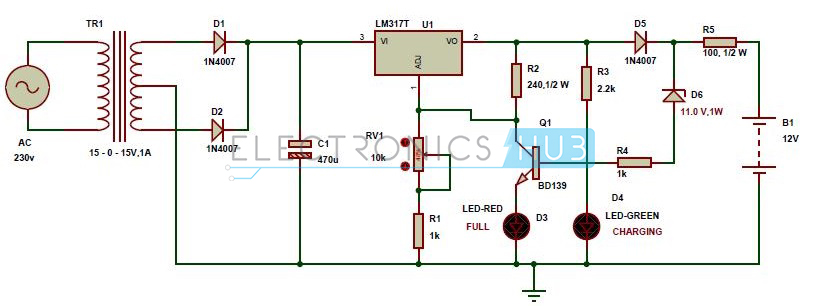POST ISSUE 04 of 2016_12_22
Hi BM,
Interesting battery charger.
As Mike says in post #2, the circuit is pretty imprecise and there appears to be no way that the green LED will ever turn off.
The circuit has two operating modes when a battery is connected (assuming a 12V lead acid battery is being charged):
(1) Charging, where the transistor, Q1, is off and the charge current is defined by the voltage on the left of R5 and the voltage on the right of R5. In this mode the Zener diode, D3, will be non-conducting and the transistor, Q1, will be off. So the voltage on the left of R5 is set by the LM317 via the 1N4007 diode, D5.
(2) Not charging, where Zener diode, D3, is conducting and there is a feedback loop which stabilizes the voltage at the left of R5 to, red LED, D3, forward voltage (1.6V roughly) + transistor, Q1, Vbe (0.6V) + Zener diode, D6 Vr (11V) = roughly 13.2V.
Some thoughts:
(1) Green LED D4 can never turn off.
(2) The circuit will probably not fully charge a 12V lead acid battery. The float voltage is not well defined but would be around 13.2V rather than 14.1V
(3) The circuit has no decoupling capacitors so the LM317 is liable to oscillate.
(4) The minimum load current of 10 mA for an LM317 is not necessarily provided under all circuit conditions.
(5) There is no allowance in the design for leakage currents, especially in the Zener diode.
(6) I am intrigued to know why a BD139 medium power transistor is specified, rather than a small signal transistor.
(7) R1 does nothing.
(8) If the output is shorted to 0V, R5 will fry
(9) The battery charge current is not well defined
Solutions
(1) No simple/reliable solution at the moment.
(2) Fit a potentiometer to set the float voltage.
(3) Connect a 220nF disk ceramic capacitor from the input pin of the LM317 to the ADJ pin of the LM317. Connect a 220nF disk ceramic capacitor from the output pin of the LM317 to the ADJ pin of the LM317.
(4) Change R2 to 120R. (in theory, the 10K variable resistor should be changed to 5K).
(5) Connect a 10K resistor from Zener diode, D6 lower, to 0V.
(6) Fit a small signal transistor in place of the BD139: BC546 etc
(7) Remove R1 and replace with a wire link (or leave R1 in circuit- it makes no difference)
(8) Make R5 at least 3W power rating.
(9) No simple/reliable solution at the moment.
Just for reference:
https://www.electronicshub.org/automatic-battery-charger-circuit/
https://www.st.com/content/ccc/reso...df/jcr:content/translations/en.CD00001225.pdf
https://www.ti.com/lit/ds/symlink/lm317.pdf
https://www.fairchildsemi.com/datasheets/BC/BC546.pdf
12V lead acid battery voltages
(1) Nominal: 12.6V (2.25V per cell)
(2) Minimum discharge voltage: 10.5V (1.75V per cell)
(3) Maximum charge voltage 14.10V (2.35V per cell): good balance between battery life and capacity.
spec




